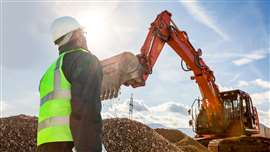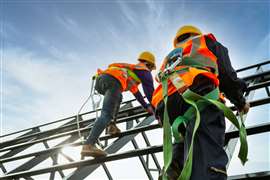Can technology make construction safer?

Partner Content produced by KHL Content Studio
22 July 2024
Construction may never completely escape its reputation as a high-risk industry.
 The risk of injury is raised when construction workers are operating in close proximity to heavy equipment. Photo: Adobe Stock
The risk of injury is raised when construction workers are operating in close proximity to heavy equipment. Photo: Adobe Stock
Although things are changing, in terms of more advanced safety protocols, and a strong recent focus on safety training and equipment, there are nevertheless few lines of work that boast as many fatal incidents.
This is true, even in the heavily regulated construction markets of Europe and North America, where the number of fatalities has continued to rise in recent years.
At the same time, the importance placed on health and safety has never been greater and modern construction businesses see it as vital to ensure their own safety records are solid.
With that in mind – and particularly since the benefits of technology were highlighted during the coronavirus pandemic – many are suggesting that digital solutions could hold the key to significantly reducing risks in construction.
 Intelex’s health and safety practice leader, Scott Gaddis. Photo: Intelex
Intelex’s health and safety practice leader, Scott Gaddis. Photo: Intelex
To do this, supporters say technology products will do more than counteract the potentially dangerous variables that occur on site on a daily basis – they will fundamentally change the way construction workers think and feel as they undertake jobsite applications.
How safety is changing in construction
Scott Gaddis is a health and safety practice leader with the technology firm Intelex. He grew up in a construction family and learned early on in his career that risks come with the territory.
He says, “I think in the past, many of us accepted a level of risk in construction that we would not accept in other industries. But that really is starting to change.
“There is a tremendous amount of variability in construction but our job as safety and health professionals, is to look for those variabilities – the errors that lay out there in the work system – and build controls for them, so they don’t happen.”
Gaddis works with technology specialists on a daily basis, helping them develop tools that have the power to transform a company’s safety culture.
 Understanding the correct use of safety equipment is essential for construction workers. Photo: Adobe Stock
Understanding the correct use of safety equipment is essential for construction workers. Photo: Adobe Stock
He says, “We’re now more adept at pushing programming features that have improved safety in other sectors and we’re adapting them to construction.
“We’re seeing technology’s influence in not only looking for behaviour, but addressing that through human and organisational performance programmes.
“Training and skills development has improved, as well as inspections and auditing – largely because we can put a device in your hand, we can make it part of what you need to do.”
Health, safety and the bottom line
KHL’s Tony Radke is a former safety specialist with 18 years’ experience in the health and safety arena.
He agrees with Gaddis that things have changed in the way construction businesses view the safety issue.
“You used to have safety professionals within companies pulling their hair out trying to deal with unsafe behaviours that can lead to accidents and injuries, and trying to communicate that to a management that didn’t want to invest the money required for training or resources to effectively manage the situation.
 KHL’s Tony Radke boasts 18 years’ experience as a health and safety professional. Photo: KHL
KHL’s Tony Radke boasts 18 years’ experience as a health and safety professional. Photo: KHL
“What really turned the tide was showing the impact on the bottom line, whether that be in obvious direct cost with injuries, or indirect costs, such as loss of production, training and hiring.
“Additionally, with insurance, as soon as a company realises the impact that high loss rates and injuries had on their insurance costs, they started to take notice.”
Another factor that seems to be aiding the shift to safer practices is the ability to win contracts.
Radke says, “A company with a poor track record for safety will find it increasingly difficult to get new work – especially in a construction sector with pre-qualification processes.”
Could all tech be safety tech?
The potential for digital technology to impact every aspect of the construction workflow has been widely recognised, and its implications from a safety perspective are being closely examined by many industry bodies.
 Accidents caused by falling objects are one of the greatest risks on construction sites. Photo: Adobe Stock
Accidents caused by falling objects are one of the greatest risks on construction sites. Photo: Adobe Stock
EFCA, the European association of consulting engineers, has been examined the health and safety potential for numerous on-site technologies.
The organisation’s director general, Sue Arundale, says, “We’ve been looking for a few years at how surveillance equipment, particularly drones, could be used to scan sites for potential hazards, and how cobots [collaborative robots] could be used to do some of the heavy lifting work, as well as some of the very repetitive and potentially hazardous work.
“We’ve also looked at how exoskeletons could offer solutions to reduce the strain on workers’ bodies, as well as making work less dangerous.
“At the same time, we know there are disadvantages to some of these technologies. Cobots, for example, don’t see in the way that a human sees, so the potential for collisions has to be considered.
 Sue Arundale, director general, EFCA. Photo: EFCA
Sue Arundale, director general, EFCA. Photo: EFCA
EFCA is also exploring the potential of AI in scenario planning, which could have significant ramifications from a safety perspective.
The organisation is currently involved in a research project, in tandem with a German university. Students there are working on prompt engineering, which is used in conjunction with AI, to look at scenarios that include climate resilience in construction.
Arundale says, “I think this technology could potentially also be used in scenario planning for safety.
“As of now,” she says, “it’s hoped that this very new technology will cut the time engineers spend working out scenarios; currently that means amassing a huge amount of data over the course of weeks or even months, before producing results. AI has the potential to do this in a day.”
Best practice in your hands
 Safety protocols are imperative for those working at height. Photo: Adobe Stock
Safety protocols are imperative for those working at height. Photo: Adobe Stock
In an environment as dynamic as a construction site, where decisions must often be made without delay, having best practice health and safety information readily available is key.
Gaddis believes this requires a safety management system that’s equally dynamic, but also one that is easily accessible to those working on the jobsite.
He says, “Technology allows us to overcome some of these hurdles, by potentially putting a device in the hands of a frontline employee.
“Everyone has a mobile phone in their pocket. The question I always ask is, can I use it effectively to help do the things that are really important in safety and health?
“Can I literally put a digital safety management system in someone’s hands; can I have activities for employees to do that not only helps me from the input side, but also them on the output side?
“In other words, can I continue a 24/7, 365 conversation with someone whose safety I care about?”
Human and machine learning
Many of today’s safety professionals are utilising machine learning and artificial intelligence to create data sets to give context to what’s happening right now in the work environment.
Gaddis believes some of the benefits of technology are now seen as nothing less than an essential part of the working environment for new – and particularly younger – employees.
“We’re seeing a tremendous amount of learning activity, performed through technology,” he says. “Especially this notion of micro-learning, in which a worker’s capabilities are enhanced by learning in three- or four-minute sessions – and that’s working really well.
“If you’re a millennial or a gen z, you’re demanding that you have these small chunks of learning opportunity – usually through a mobile device.
“Ultimately, with technology – everything from drones to limiting risk through software – it really is all about having the entire workforce on board with us, to create a safer environment.”
STAY CONNECTED



Receive the information you need when you need it through our world-leading magazines, newsletters and daily briefings.
CONNECT WITH THE TEAM







